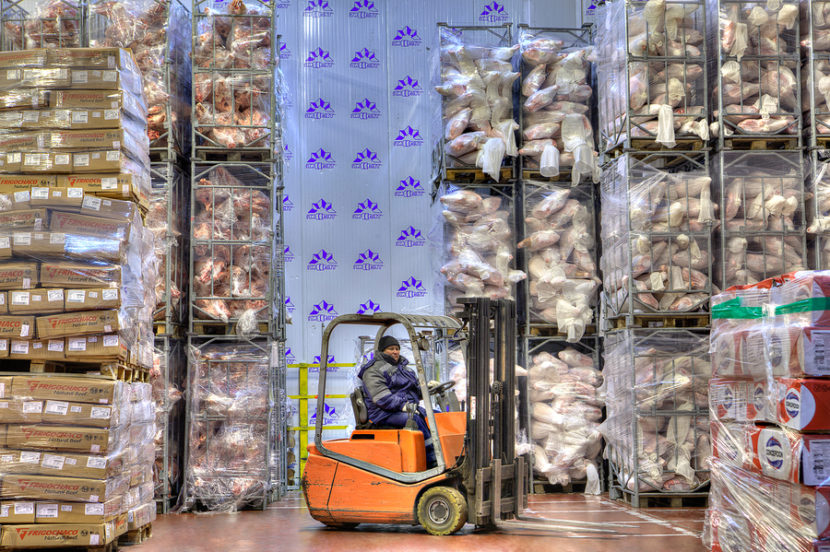Obtaining High Achievement in Your Warehouse Facility Requires Oversight and Commitment to an Accredited Standard
By Jaan Koel
From a food safety perspective, food manufacturing is one thing, and food storage and warehousing is another. Both can occur in the same plant, where food is produced, and then packaged and stored for direct shipment to retailers, restaurant chains, catering companies, and other customers.
In other cases, food–usually in large and varied amounts—is shipped to third-party distributors, who use their own warehouses to store the products until they’re ready to be consolidated on trucks and go out to market.
Three Different Environments
From a regulatory perspective, food manufacturing and food storage and warehousing share many of the same protocols and standards—FSMA, GFSI, Safe Food for Canadians, CFIA, and others. As with manufacturing, storage and warehousing rules are continuing to tighten.
There are three primary environments. These include frozen (where temperatures are kept at freezing or below), refrigerated (with temperatures ranging from 34-39 degrees F), and dry foods (which operate between 50-70 degrees F). Some facilities include all three, others just two (usually frozen and refrigerated), or, in rare cases, only one (dry).
As with manufacturing, storage and warehousing rules are continuing to tighten.
All three have their own food safety demands. Apart from ensuring temperatures stay within specified ranges, they share some important structure-related parameters.
A number of Registrars (Certification Bodies) have become recognized certifiers of food safety practices in food distribution centres throughout the world.
“All of these organizations look for at least five food storage and warehousing inspection measures: methods and practices; maintenance; cleaning, pest management; and corporate management,” says Lowell Randel, Vice President of Government and Legal Affairs at Global Cold Chain Alliance in Alexandria, VA. “And they’re all linked into the benchmarks set out by GFSI, and administered through recognized schemes, such as BRC, SQF and others.”
Methods and practices are pretty general in scope, and are also applicable to food processing facilities. Measurements include how carefully staff members handle raw and perishable foods, reject contaminated shipments, keep track of proper storage temperatures, and maintain a clean working environment overall.
Maintenance is about the facility itself: how well designed it is; how well lit it is; how secure it is from cracks in walls, foundation and floors; and how well-protected it is from water seepage; electrical, and other hazards.
“Cleaning is related to maintenance, but with a special focus on systems that minimize the possibility of bacterial infection and cross contamination of food with food, and food with hazardous agents,” says Kerry Beach, spokesperson for AIB International, a globally recognized food safety provider based in Manhattan, KS. Hand and shoe washing stations are an important part of this, as is making sure all cleaning machines and materials are kept in peak condition.
“Pest infestation is also extremely important. There are companies that specialize in preventing exactly that,” she adds. Building maintenance is key—making sure there are no breaches in walls or foundations that can let little critters inside and have the run of the place. Other measures include a variety of traps that can catch those that do manage to get inside.
Management is largely about people—how committed they are to a food safety culture and ensuring employees receive up-to-date training in all aspects of food safety and hygiene to meet compliance standards. Inspectors take a keen interest in making sure management conducts its own internal audits on a regular basis, conducting ongoing educational programs and activities for employees related to food safety, and ensuring foods don’t become contaminated.
The passing grade for inspections is “high achievement,”or equivalent, which protects the health of you, your kids, and all of us.
“Retailers such as Walmart want warehouses, manufacturers, and all other suppliers to conform with GFSI-based accreditation standards. That’s where the supply chain is now, and where it’s going in the future,” says Randel.
About the Author
Jaan Koel is a respected food safety writer with a substantial portfolio developed over many years of front line writing experience. He began contributing to GFSR six years ago and is a regular contributor to other industry leading business-to-business publications. Aside from his expertise in the area of article writing, he has developed a strong credibility writing in the areas of corporate communications, public relations, government communications and marketing.

-
 FeaturedRisk management
The Cost of a Breach: What a Cyberattack Could Mean for Food Safety Recalls
FeaturedRisk management
The Cost of a Breach: What a Cyberattack Could Mean for Food Safety Recalls
-
 FeaturedRisk management
Securing the Food Chain: How ISO/IEC 27001 Strengthens Cybersecurity
FeaturedRisk management
Securing the Food Chain: How ISO/IEC 27001 Strengthens Cybersecurity
-
 FeaturedRisk management
Revolutionizing Food Safety Training: Breaking Out of the “Check-the-Box” Mentality
FeaturedRisk management
Revolutionizing Food Safety Training: Breaking Out of the “Check-the-Box” Mentality
-
 GFSI Standards
GFSI 2025: Building Trust, Tech-Forward Solutions, and Global Unity in Food Safety
GFSI Standards
GFSI 2025: Building Trust, Tech-Forward Solutions, and Global Unity in Food Safety
-
 FeaturedFood Safety
Integrated Pest Management: Strategies to Protect Your Brand’s Reputation
FeaturedFood Safety
Integrated Pest Management: Strategies to Protect Your Brand’s Reputation
-
 FeaturedFood Safety Culture & Training
No Open Door Policy: Challenges That Impact Pest Control in Food Processing Plants
FeaturedFood Safety Culture & Training
No Open Door Policy: Challenges That Impact Pest Control in Food Processing Plants



